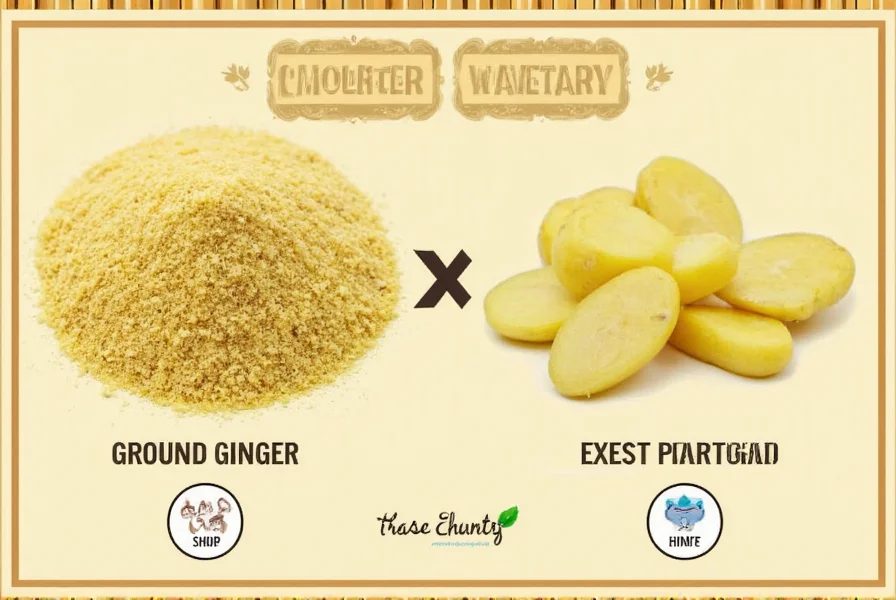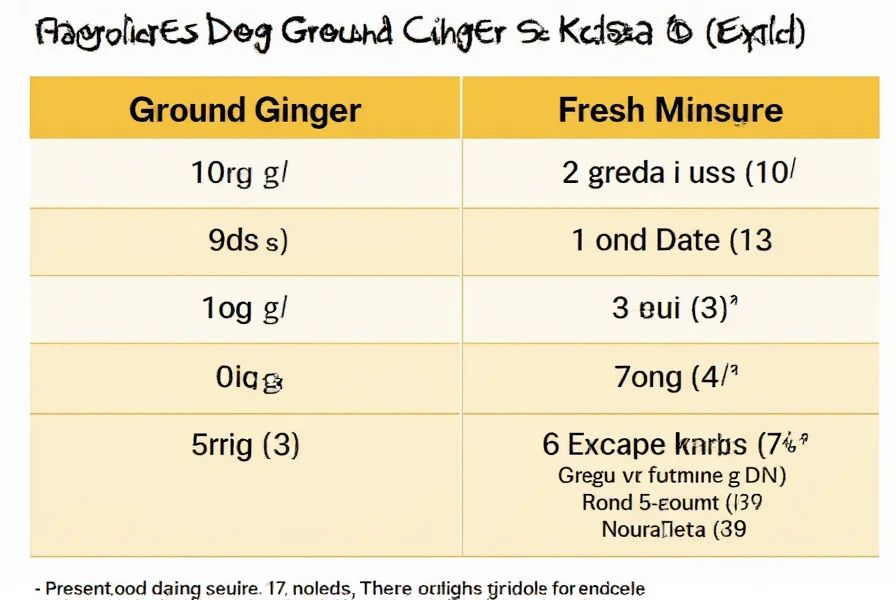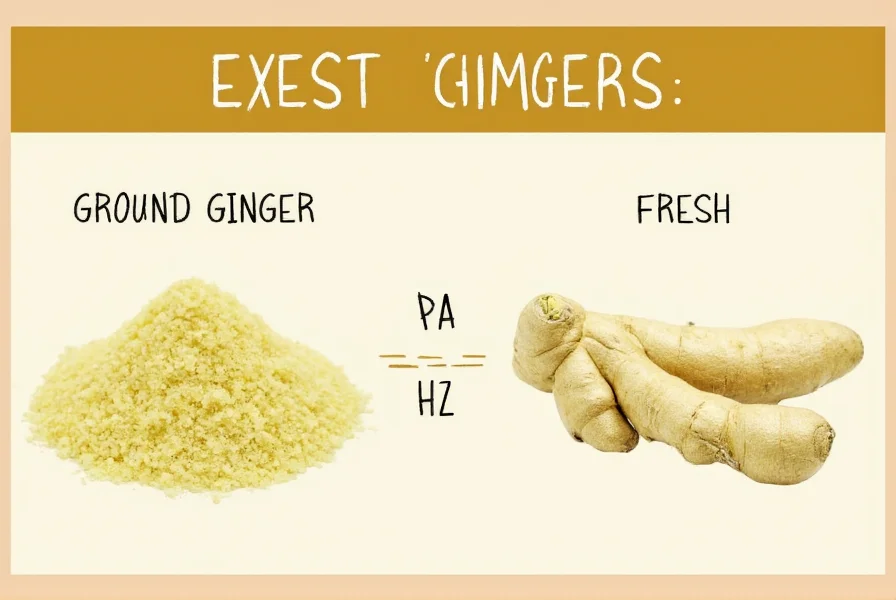The standard conversion ratio is 1/4 teaspoon of ground ginger equals 1 tablespoon of fresh ginger. This 1:3 ratio accounts for the concentration difference between dried and fresh forms. When substituting in recipes, use this precise measurement to maintain intended flavor balance without overpowering your dish.
Understanding the proper conversion between ground and fresh ginger is essential for achieving consistent results in cooking and baking. Many home chefs encounter recipe frustration when they mistakenly use equal measurements of these two forms, not realizing that dried spices concentrate significantly during processing.
Why Ground and Fresh Ginger Aren't Interchangeable by Volume
Ground ginger undergoes a drying process that removes approximately 80% of fresh ginger's water content. This concentration means ground ginger delivers more intense flavor in smaller quantities. The chemical composition changes during drying, with gingerols (the primary compounds in fresh ginger) partially converting to shogaols, which are more pungent and stable.
When you're substituting ground ginger for fresh in recipes, remember that dried spices generally have three times the potency of their fresh counterparts. This explains why the conversion isn't a simple 1:1 ratio but rather requires careful measurement adjustment.
Practical Conversion Guide for Common Measurements
| Ground Ginger | Equivalent Fresh Ginger | Best Used For |
|---|---|---|
| 1/8 teaspoon | 3/4 teaspoon, grated | Delicate sauces, beverages|
| 1/4 teaspoon | 1 tablespoon, grated | Standard baking recipes|
| 1/2 teaspoon | 1 1/2 tablespoons, grated | Hearty stews, curries|
| 1 teaspoon | 3 tablespoons, grated | Strong-flavored dishes, preserves
Flavor Profile Differences You Should Know
While the conversion ratio provides measurement guidance, understanding flavor differences prevents recipe disappointment. Fresh ginger substitution for ground ginger yields brighter, more citrusy notes with sharper heat that dissipates quickly. Ground ginger offers warmer, more earthy flavor with longer-lasting warmth but less complexity.
Consider these factors when deciding whether to substitute:
- Recipe cooking time: Long-cooked dishes benefit from ground ginger's stability
- Desired flavor prominence: Fresh works better when ginger should shine
- Texture requirements: Ground won't add moisture like fresh grated
- Dish temperature: Fresh ginger's volatile compounds diminish in hot preparations

When Substitution Requires Additional Adjustments
Simple measurement conversion isn't always sufficient. In moisture-sensitive recipes like cakes or cookies, replacing fresh ginger (which contains water) with dry powder may require slight liquid adjustments. For every tablespoon of fresh ginger substituted with ground, consider reducing other liquids by 1-2 teaspoons.
When working with ground ginger equivalent to fresh in baking, remember that fresh ginger's moisture content affects texture. In delicate pastries, this difference can impact final product structure. For best results in baking, use ground ginger when recipes specifically call for it, as developers have already balanced the formulation.
Storage Considerations Affecting Potency
The age of your ground ginger significantly impacts substitution accuracy. Properly stored in an airtight container away from light, ground ginger maintains peak potency for 2-3 years, while fresh ginger lasts 2-3 weeks refrigerated or 6 months frozen.
Older ground ginger loses potency, potentially requiring slightly increased measurements. If your ground ginger has been sitting in the pantry for over a year, you might need to use 25-30% more than the standard conversion to achieve equivalent flavor.

Recipe-Specific Conversion Examples
For gingerbread cookies: If a recipe calls for 2 tablespoons fresh grated ginger, use 2/3 teaspoon ground ginger. Since baking involves long cooking times, ground ginger's stable compounds distribute evenly throughout the dough.
For stir-fries: When substituting ground for fresh in quick-cooking dishes, add ground ginger early in the cooking process to allow flavors to bloom. For 1 tablespoon fresh ginger, use 1/4 teaspoon ground ginger mixed with 1 teaspoon water to approximate fresh ginger's moisture contribution.
For ginger tea: Fresh ginger provides brighter flavor in beverages. If using ground ginger instead of fresh, steep 1/8 teaspoon in hot water for 5-7 minutes rather than the 10-15 minutes fresh would require.
Professional Chef Recommendations
Many professional chefs maintain both forms in their kitchens for different applications. Executive chef Maria Rodriguez notes: "I reach for fresh ginger when I want that bright, zesty kick in seafood dishes or salad dressings, but ground ginger gives me consistent warmth in spice blends and baked goods where fresh would create texture issues."
For authentic Asian cuisine, fresh ginger generally provides superior results. However, for spice-forward dishes like Indian curries or Middle Eastern spice mixes, ground ginger often integrates more smoothly with other dried spices.
Frequently Asked Questions
Can I use ground ginger instead of fresh in ginger shots?
For ginger shots, fresh ginger is strongly preferred as ground ginger creates an unpleasant gritty texture and lacks the bright, volatile compounds that provide the characteristic zing. The conversion ratio doesn't account for texture differences that are critical in this application.
Does the conversion ratio change for crystallized ginger?
Yes, crystallized ginger requires different conversion. One tablespoon of crystallized ginger (chopped) equals approximately 2 teaspoons fresh ginger. The sugar content and partial dehydration create a different concentration than either ground or raw ginger.
How do I adjust recipes when substituting fresh for ground ginger?
When using fresh ginger instead of ground, multiply the ground ginger measurement by 3. For example, if a recipe calls for 1 teaspoon ground ginger, use 3 tablespoons freshly grated ginger. Remember that fresh ginger adds moisture, so you may need to reduce other liquids slightly in baking applications.
Why does my substitution sometimes taste too strong or too weak?
Several factors affect substitution success: ginger age (older ground ginger loses potency), growing conditions (which affect gingerol concentration), and recipe cooking time. For critical recipes, start with 75% of the calculated conversion, then adjust to taste before finalizing your dish.
Can I make my own ground ginger from fresh?
Yes, but commercial ground ginger undergoes specialized drying that concentrates flavor differently than home methods. To make your own, peel and thinly slice fresh ginger, dehydrate at 140°F until brittle (8-12 hours), then grind to powder. Note that homemade ground ginger will be less potent than store-bought, requiring approximately 50% more for equivalent flavor.











 浙公网安备
33010002000092号
浙公网安备
33010002000092号 浙B2-20120091-4
浙B2-20120091-4